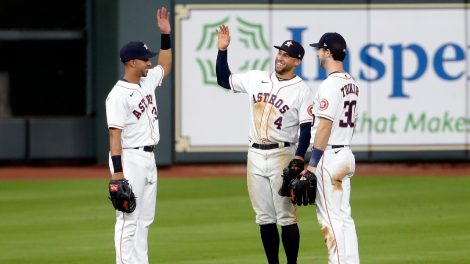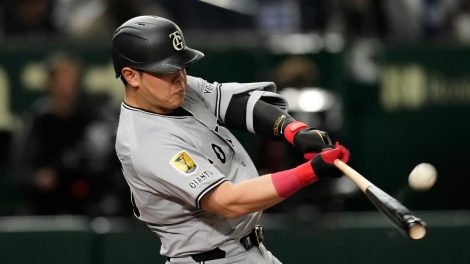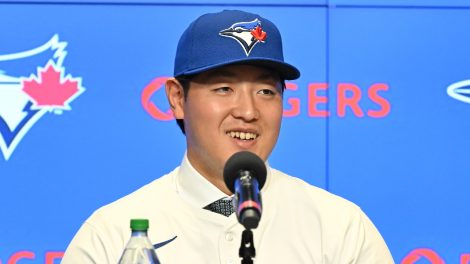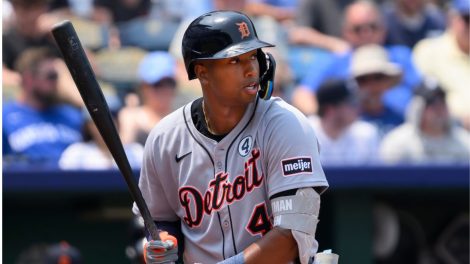TORONTO – There are two primary themes emerging for the Toronto Blue Jays in these early days of the off-season that bear close watching in the days and weeks ahead.
First, they’re looking at this week’s acquisition of righty Chase Anderson from the Milwaukee Brewers as a floor for the starting rotation, rather than a ceiling, an injection of stable innings providing a base while more impactful arms – at least one and up to three – are pursued.
Second, anything GM Ross Atkins and company have planned on the position player side is tied, to a degree, to what they do on the pitching end of things, and to how much more runway they want to provide to the players they already have in-house.
For example, if they traded someone like Lourdes Gurriel Jr. for a starting pitcher, they’d then need to suddenly jump into the free-agent market for another outfielder. Their catchers have also been drawing interest from other clubs. On the flip side, if they do their pitching work in free agency, then any bat signed takes away reps from a group of players that includes Teoscar Hernandez, Derek Fisher and Rowdy Tellez.
Do they actually want to do that? Are they ready to move on from them, or do they merit a little more run before that call is made?
[relatedlinks]
As such, everything the Blue Jays do from here on out is somewhat interconnected, and it will be intriguing to see how they advance things during the General Managers Meetings in Scottsdale, Ariz., next week. According to one agent representing an offensive player, their priority right now is clearly on bolstering the rotation, which is understandable.
To that end, while the Blue Jays don’t feel the roster is at a point where they should be aiming at the likes of Gerrit Cole and Stephen Strasburg just yet, they do seem willing to drive the market on certain arms, already engaging some in preliminary talks.
That’s much different from the sit-back-and-wait-for-opportunities approach they’ve used the past couple of winters, and if it leads to real action rather than idle talk, represents the potential for a significant step forward.
“The new inefficiency is actually spending,” quipped another agent.
In an ideal world, the Blue Jays are adding a couple of starters from the middle and or upper tiers of the free agent market – think guys subject to qualifying offer compensation like Zack Wheeler and Jake Odorizzi along with Dallas Keuchel, Kyle Gibson, Michael Pineda, Wade Miley (whom they’ve pursued in the past), Tanner Roark, Jordan Lyles, Alex Wood, Julio Teheran and Rick Porcello – and perhaps bringing back Matt Shoemaker, too.
The trade market offers a secondary path forward, and in both cases the Blue Jays appear intent on moving past the bounce-back, value-reclamation types they locked in on the previous two winters.
That they’re not ruling out Wheeler and Odorizzi – whom manager Charlie Montoyo knows from the Tampa Bay Rays – is interesting, as surrendering draft pick compensation had been a non-starter for them in years past.
Should the Blue Jays sign a qualified free agent, they would lose their second-highest selection in the upcoming draft as well as $500,000 from their international bonus pool. On the draft end, that means forfeiting a pick in the mid-40s overall along with the roughly $1.6 million in bonus pool room (based on 2019 slots) that comes with it – a steep but not prohibitive cost.
Either way, the Blue Jays have the spending power this winter to add multiple players who can make an impact.
[snippet id=4722869]
A home run off-season for the Blue Jays would include two starters that would make Shoemaker a three, Anderson a four, with one of incumbents Ryan Borucki and Trent Thornton competing for five.
In that scenario, young arms like Nate Pearson, T.J. Zeuch, Anthony Kay, Jacob Waguespack, Thomas Pannone, Sean Reid-Foley, Patrick Murphy, Hector Perez and Yennsy Diaz are all pushing upwards from triple-A Buffalo and double-A New Hampshire, offering the type of near-term depth so lacking in recent years.
Should Pearson, as expected, and others force their way upward, the Blue Jays would then have surplus to trade ahead of the July 31 trade deadline, replenishing assets for the farm system.
Given how poor their pitching was in 2019 – remember how they sifted through 39 pitchers, including position players Luke Maile and Richard Urena, last summer? – such a scenario would present a massive leap forward.
Top that off with a couple of position players to bolster the kids, and the Blue Jays suddenly become a pretty interesting club.
Interesting enough to contend? Probably not, but enough to make a .500 season seem attainable, with bolder strikes that propel them into legit contention coming ahead of 2021.
Again, talking is easy. Doing is hard. Just like the grind of 162 games often lays the best-laid plans to waste, the winter’s churn does the same to the most carefully crafted spending scenarios.
But indications, at least to this point, are that the Blue Jays are trying in a way they haven’t the past few winters. That’s a start.








